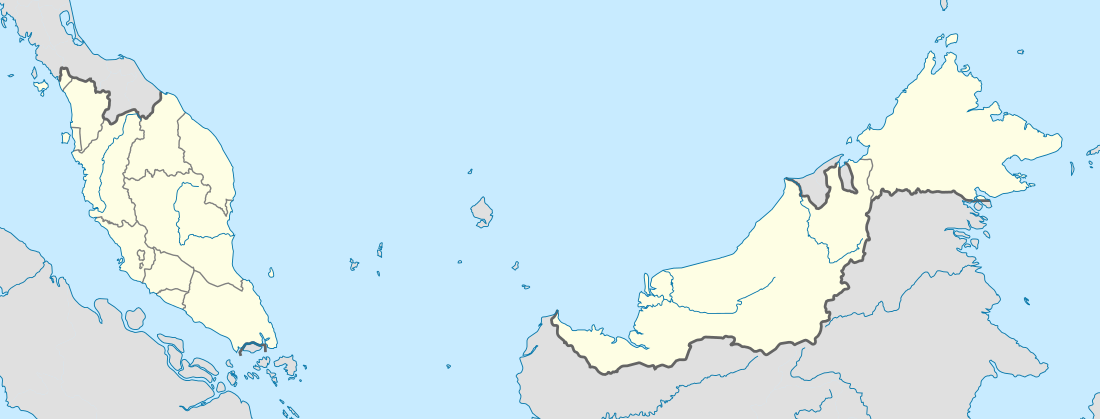Ampang, Selangor
| Ampang | ||
|---|---|---|
| Other transcription(s) | ||
| • Chinese | 安邦 | |
| • Tamil | அம்பாங் | |
| • Jawi | امڤڠ | |
%2C_Ampang_town%2C_Selangor.jpg) | ||
| ||
| Motto(s): Bakti, Bersih, Berbudaya | ||
 Ampang Location in Malaysia | ||
| Coordinates: 3°9′0″N 101°46′12″E / 3.15000°N 101.77000°ECoordinates: 3°9′0″N 101°46′12″E / 3.15000°N 101.77000°E | ||
| Country |
| |
| State | Selangor | |
| Granted Municipal Status | 1 July 1992 | |
| Government | ||
| • Administered by |
Majlis Perbandaran Ampang Jaya (Ampang Jaya Municipal Council) | |
| • Yang diPertua (Councillor) | Mohammad Yacob | |
| Area | ||
| • Total | 143.5 km2 (55.4 sq mi) | |
| Population (2010) | ||
| • Total | 126,285 [1] | |
| • Density | 880/km2 (2,300/sq mi) | |
| Time zone | UTC+8 (MST) | |
| • Summer (DST) | Not observed | |
| Website | http://www.mpaj.gov.my | |
Ampang Jaya, more commonly known as just Ampang (Chinese: 安邦) (Tamil: அம்பாங்), is a town, a mukim and a parliamentary constituency in Hulu Langat District and parts of Gombak District, Selangor, Malaysia. It borders a district within Kuala Lumpur also known as Ampang. It is administered by the Ampang Jaya Municipal Council (MPAJ), which is the formal name of the township itself as well. The member of parliament for Ampang is Zuraida Kamaruddin, who is the current Minister of Housing and Local Government of Malaysia.
History
According to the history, Kuala Lumpur was founded in 1857 at the confluence of the Sungei Lumpur (now Gombak River) and the Klang River, which now houses the Kuala Lumpur Jamek Mosque. Before the arrival of the Chinese people for tin mining, Kuala Lumpur was just a small hamlet with just a few houses and a shop or two.[2] Raja Abdullah, who is also the representative of the Sultan in Klang, and Raja Juma'at of Lukut sent 87 Chinese miners from Lukut in 1857 to open tin mines in Ampang, thus began the development of Kuala Lumpur.[3] Ampang was one of the earliest areas in the Klang Valley to be opened for tin mining. The name "Ampang" means "dam" in Malay and the place was named in reference to the miners' dams.[2] A road was built to connect Ampang to Kuala Lumpur which formed the Jalan Ampang of today.
Pekan Ampang, a small town situated approximately 3 km from Kampung Lembah Jaya small village. The architecture of the building in the town just like most towns and cities in the developing world during the British colonial period. Originally Pekan Ampang is a separate town, but now it was absorbed as part of the metropolitan area of Kuala Lumpur.
Geography
%2C_Ampang%2C_Selangor.jpg)
Situated to the east of Kuala Lumpur, Ampang is easily accessible from Jalan Tun Razak or Jalan Ulu Kelang from the Hulu Klang or Setapak areas. It is also accessible from Cheras through Jalan Shamelin, from Jalan Tun Razak through Jalan Kampung Pandan via Taman Cempaka, from Kampung Pandan through Jalan Kampung Pandan Dalam via Taman Nirwana, from MRR2 via Pandan Indah & Taman Kencana and from Hulu Langat town through the mountain pass. Taman Melawati, Wangsa Maju, Setapak, Kuala Lumpur City Centre and Salak Selatan are close to Ampang.
Neighbourhoods
The oldest neighbourhoods are
- Kampung Tasik
- Tasek Permai
- Ampang New Village
- Ampang Town
- Ampang Malay Village
- Ampang Newtown
- Taman Dagang
- Dato' Ahmad Razali Flats
- Taman Nirwana
Other major neighbourhoods in Ampang are
- Ampang Indah
- Ampang Mewah
- Ampang Permai
- Ampang Jaya
- Lembah Jaya
- Taman Dagang
- Taman Ampang Indah
- Kampung Ampang Indah
- Taman Dagang Jaya
- Taman Cahaya
- Taman Cempaka
- Taman Bakti
- Taman Nirwana
- Taman Kosas
- Taman Sri Watan
- Taman Rasmi Jaya
- Taman Bukit Indah
- Taman Kesuma
- Taman Hillview
- Taman Sri Raya
- Taman Tasik Tambahan
- Taman Putra
- Ulu Kelang
- Pandan Jaya
- Pandan Indah
- Taman Tun Abdul Razak (Taman TAR)
Taman TAR is one of the most expensive residential areas in the country.
Palace
The Istana Daerah Hulu Langat is a palace in Ampang, located near apartments along Jalan Kosas Utama, opposite the Ampang Waterfront. It is the official residence of the Yang-Amat Berbahagia Tengku Mahkota of Hulu Langat, a member of the Selangor royal family. The palace was built in 1990 and has been undergoing major renovations since 2010. It will reopen at the end of 2012. The residence was originally separated apartments, with each connected to the other by short and narrow passageways. The palace is not normally open to the public, although the beautiful gardens around it can be viewed from outside.
Food
Since Ampang area mainly resides by the Malays, you can easily find any Malay dishes and also Indo-Malay cuisines. Ampang famous for its Lemang , a Malay sticky rice with coconut milk in bamboo. Lemang stalls can be found at any major roadsides in Ampang. Other than that, Ampang also famous for Burger Bakar (Toast Burger), Satay, Laksa and variety of Malay kueh. Popular food districts in Ampang includes Taman Muhibbah, Taman Dagang, Desa Pandan, Lembah Keramat, Bukit Antarabangsa and Pandan Indah.
Ampang is also quite famous for its Yong tau foo, a Chinese stuffed vegetable soup dish with Hakka origins. Three restaurants in Kampung Baru Ampang (Restoran Foong Foong, Ampang Yong Tau Foo and Ampang Homeland) and Restoran Jing Ji Xiang in Taman Cahaya serve the dish. Ampang also has many foreign restaurants, mostly near the Ampang One Avenue apartments near the Ampang Point shopping complex.
Education

The International School of Kuala Lumpur (ISKL) secondary campus is in Ampang. The ADNI Islamic school is also based in the town.
Primary School
- SK Tasek Permai
- SK Taman Tasik
- SK Taman Nirwana
- SK Taman Kosas
- SK Taman Bukit Indah
- SK Lembah Jaya
- SK Hulu Kelang
- SK Ampang Campuran
- SK Ampang
- SK (2) Kuala Ampang
- SK (1) Kuala Ampang
- SJK (T) Ampang
- SJK (C) On Pong 2
- SJK (C) On Pong
- SJK (C) Kampung Baru Ampang
Secondary School
- SMK Tasek Permai
- SMK Taman Tasik
- SMK Taman Seraya
- SMK Taman Kosas
- SMK Pandan Indah
- SMK Hulu Kelang
- SMK Dato' Ahmad Razali
- SMK Bukit Indah
- SMK Bandar Baru Ampang
Shopping
Ampang has a few small shopping complexes such as Ampang Point (near One Ampang Avenue and beside the Kuala Lumpur Middle Ring Road 2 (MRR2), MidPoint (Pandan Indah), Paragon (Taman Muda Ampang), Pandan Kapital (beside Menara MPAJ in Pandan Indah), Spectrum Mall Ampang (Bandar Baru Ampang), Galaxy Ampang (near Taman Nirwana Ampang) and Ampang Tesco (beside the MRR2 near the Pandan Jaya exit) and also a newly opened Aeon Big (previously known as Carrefour) Ampang at the end of Jalan Ampang, near Taman Dagang.
Hospitals
Ampang has three hospitals:
- Ampang Putri Hospital (behind Ampang Point shopping complex);
- Pantai Hospital Pandan Indah (in Pandan Indah); and
- the public Hospital Ampang (in Pandan Mewah).
Parks
For nature lovers, the National Zoo of Malaysia (Zoo Negara) is nearby and is one of the best attractions in Ampang, Selangor. Located in Hulu Klang, the National Zoo is only 10 minutes away from Ampang through Jalan Hulu Klang from Ampang Point shopping mall.
Virtually unknown to outsiders, Taman Rimba Ampang (Ampang Recreational Forest) is a small recreational park with a small & shallow river. Those who want a short break from the busy Kuala Lumpur city life can visit this park for its quiet environment and the river's cool and clear waters. The Kuala Lumpur Look Out Point Tourist Complex was another popular hot spot located at Jalan Ampang–Hulu Langat but is closed for safety reasons.
Politics
Ampang is represented in the Dewan Rakyat of the Malaysian Parliament by Zuraida Kamaruddin of PKR. She has held the seat since 2008.
On the state level, Ampang contributes two seats to the Selangor State Legislative Assembly, namely:
- Lembah Jaya, represented by Khasim Abdul Aziz of PAS; and
- Bukit Antarabangsa, represented by Azmin Ali of PKR, who is also the incumbent Menteri Besar of Selangor.
The Ampang Jaya municipality however also covers the Pandan parliamentary constituency and the Hulu Klang state constituency within the Gombak parliamentary constituency.
Transportation
Car
Effectively a suburb of Kuala Lumpur, Ampang is well connected to other places by a series of federal highways, tolled highways and state routes. Jalan Ampang
![]()
![]()
![]()
![]()
![]()
Public transportation
AG18 Ampang is the namesake and terminus of the Ampang Line, which is Malaysia's first LRT/metro system. The station, renovated in 2012, is located along Jalan Ampang. The stretch between Ampang and Plaza Rakyat used to be part of KTM Intercity until the 1990s. KTM presently does not serve Ampang or its surroundings.
Other than the aforementioned Ampang station, the Ampang Jaya municipal district is also served by the AG17 Cahaya, AG16 Cempaka, AG15 Pandan Indah and AG14 Pandan Jaya stations, all on the Ampang Line.
The Cempaka-Pandan Jaya stretch is however not in Ampang proper, but located in the adjacent constituency of Pandan instead.
According to unofficial proposals, a MRT Circle Line, surrounding downtown Kuala Lumpur would be built. Ampang station was reportedly one of the possible stops, along Abdullah Hukum, Bandar Malaysia, Segambut, Sentul Timur, Jelatek and Taman Midah.
Besides the LRT, bus and taxi options are available. For example, rapidKL bus route 300 leads from the Ampang LRT station to KLCC.
Sister cities
See also
- Ampang, Kuala Lumpur, Kuala Lumpur's portion of greater Ampang
References
- ↑ "Archived copy" (PDF). Archived from the original (PDF) on 27 February 2012. Retrieved 2012-12-05. table 13.1
- 1 2 J.M. Gullick (1983). The story of Kuala Lumpur, 1857–1939. Eastern Universities Press (M). pp. 1–2. ISBN 978-967-908-028-5.
- ↑ J.M. Gullick (1955). "Kuala Lumpur 1880–1895" (PDF). Journal of the Malayan Branch of the Royal Asiatic Society. 24 (4): 10–11. Archived from the original (PDF) on 28 May 2015.
| Wikimedia Commons has media related to Ampang, Selangor. |
